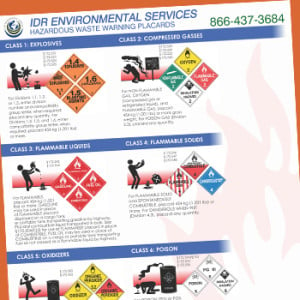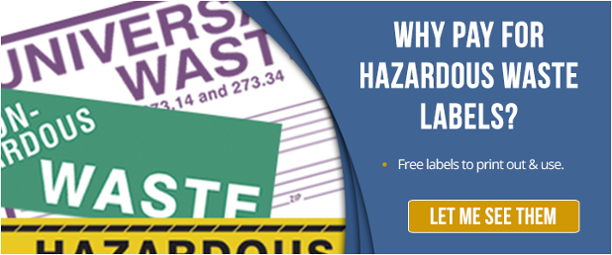Knowing what to include on a chemical waste label is an important step in ensuring regulatory compliance with federal and state hazardous waste laws.
Although it can be frustrating to try and navigate bureaucratic red tape, one thing is for sure. Not meeting waste label laws can result in costly fines and threaten the safety of your employees and community.
Though local and state laws vary, in California, the Resource Conservation and Recovery Act (RCRA) dictates any regulations hat California businesses must meet. Below we will explore what must be included on a chemical waste label so you can ensure these labels are properly filled out and marked on your hazardous waste containers.
Accumulation Date
 A chemical waste label must include the date in which the accumulation of the substance inside begins. This date must be clearly marked and visible for inspection on each unit.
A chemical waste label must include the date in which the accumulation of the substance inside begins. This date must be clearly marked and visible for inspection on each unit.
Containers and tanks used by the generator to collect or consolidate wastes initially accumulated in other containers are subject to the same labeling requirements. The initial accumulation and “90-day period” dates on the “collection” container must be the oldest of the initial accumulation and “90-day period” dates from the various tanks emptied into the “collection” container.
This may require dates to be changed if waste from older containers are added to the collection container.
‘Hazardous Waste’ Label
When a chemical is accumulated on site, each generator tank or container must be properly labeled or clearly marked with the words, “Hazardous Waste.”
Chemical Information
Each container or portable tank must be labeled with the composition and physical state of the waste. The label must also include a statement or statements that call attention to the particular hazardous properties of the waste.
Generator Information
The name and address of the hazardous waste generator must be included on a chemical waste label. Be sure to include contact information for the generator in the case of an emergency.
 Diamond Hazard Label
Diamond Hazard Label
The U.S. Department of Transportation (DOT) requires that non-bulk packages (maximum capacity no more than 119 gallons) to display at a minimum a diamond hazard label for the primary (and most subsidiary) hazard classes of the hazardous material.
Diamond hazard labels offer a visual representation of the chemical (or other hazardous waste) that is inside the container. This type of label includes visual symbols of any health hazards, as well as whether the chemical is flammable or reactive or may pose a special risk should a fire occur.
Label Location
The DOT also requires companies to properly place the label on a container so any pertinent information is not missed by anyone who is handling the drum.
Labels must appear in their entirety and should not be placed near any other markings on the surface. Never place labels near the bottom of a container. If multiple labels are needed due to multiple hazards, the DOT recommends spacing them apart by at least 6 inches. The primary hazard label should be placed above and to the left of the subsidiary hazard label.
ID And Manifest Numbers
In addition to the regulations outlined above, the U.S. Environmental Protection Agency also requires hazardous waste containers that have a capacity of 119 gallons or less to include labels that have the generator’s EPA identification number and manifest tracking number included.
The label should include the following text:
HAZARDOUS WASTE - Federal Law Prohibits Improper Disposal. If found, contact the nearest police or public safety authority or the U.S. Environmental Protection Agency.
Generator’s Name and Address ______________.
Generator’s EPA Identification Number _______________.
Manifest Tracking Number ______________.
Other Important Items To Note
While the above information pertains to California state and federal laws, it is important to check with your municipality to ensure you are meeting any local requirements as well.
One area of concern companies may have questions about include containers that are continuously reused for accumulation of the same chemical waste stream and how these containers should be labeled.
“Recurring use” labels may be used on such containers to revise the initial accumulation and “90-day” dates (without having to change the other labeling information). If the container is emptied at least once per day, the word “daily” may be used in the date area of the label.
Where To Find Labels
While pre-printed labels can be found for purchase online, they can be costly and inconvenient, especially if they are needed quickly.
IDR, however, offers free hazardous waste labels that can be used immediately on your storage containers. These labels are compliant with EPA and DOT regulations. They are also easy to access by simply downloading the label and printing it out.
While there are several other sites that offer free chemical waste labels as well, before you take advantage of these offers, make sure the labels are in compliance with EPA and DOT regulations to ensure your company is following the law.


Comment